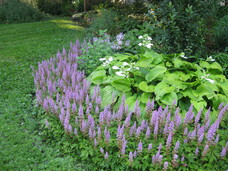AuthorLyn Chimera is a Master Gardener, consultant and lecturer. Archives
May 2023
Categories |
Back to Blog
Ground Cover Beyond Pachysandra3/4/2023  By: Lyn Chimera Plants to cover bare soil have long been a staple of any garden. Basically, any plant that covers the ground can be used as groundcover. It doesn’t have to be low growing. Groundcover provides all sorts of benefits to a garden including less weeding, protection from soil erosion, reduction of water evaporation, softening edges, and protection of perennials from harsh winter temperature fluctuations. In addition to these benefits, ground cover is also good for the environment. By replacing some lawn with ground cover, you greatly reduce watering needs and use of herbicides along while creating a better habitat for beneficial insects. Ground covers also act as a living mulch to improve soil. Ground covers can be a beautiful addition to any garden by adding interest, texture, and beauty. Pachysandra, myrtle, and ivy are the most common ground covers in our area but there are so many other options. The following are some suggestions for a variety of growing conditions. They are all deer resistant. Bugle weed (Ajuga) is a fast spreading, low growing plant for sun to shade that has a lovely purple to lavender upright bloom in the spring. It comes in a variety of foliage colors from “chocolate” to variegated. Ajuga is a good choice for an area all its own. It is an aggressive spreader once established and not a good choice for between other perennials. It also works well in blooming or bee lawns. Wild Ginger (Asarum canadense) is an outstanding shade native for hard to grow sites. It forms dense cover with somewhat large attractive heart shaped leaves about 8-10 inches high. I have a wonderful patch under a giant Norway spruce where absolutely nothing else would grow. Better used around a tree than interspersed with other pants. Spreads well when established and would overtake a perennial bed. Astilbe is a shade loving flowering plant that comes in a variety of sizes and color of bloom. Astilbe chinensis, has low growing foliage, 6 – 8 inches, with a spike of lavender bloom in late summer when not much is blooming. It makes a great dense ground cover for the front of a border. Also makes a good lawn replacement plant. Taller varieties are good ground cover for mid to back of a bed. (see photo) Gold Star (Chrysogonum virginianum) is an excellent native ground cover for sun to shade. It has deep green textured leaves with lovely yellow blooms in spring with a smaller rebloom in late summer. The whole plant stays low even in bloom. An aggressive grower that will quickly cover an area. Japanese Painted Fern (Athyrium niponicum) makes a lovely color and texture addition to any shade garden. It is lower growing than many ferns (about 12-16 inches) and has graceful arched fronds as opposed to the upright fronds on many ferns. The Japanese painted fern comes in a variety of color combinations including silver, burgundy and cream. It is not aggressive so can be used among other shade perennials. Prefers moist soil. Bishop’s hat (Epimedium) comes in a variety of sized from 6 - 18 inches tall. The various varieties come in many colors including, white, pink, rose and yellow. It’s a perfect plant for dry shade. Epimedium blooms in spring before the leaves come up. The leaves are heart shaped, some with burgundy edges that turn all burgundy in the fall and persist during winter. Not an aggressive spreader. Moss There are many varieties of moss that do well in moist, acidic shade. Once established it is a beautiful ground cover. It does need moisture so would need to be irrigated during dry periods. Many people try to remove moss growing in their yards. It’s nature’s way of telling you that’s what wants to grow there so relax and enjoy it! Moss gardening is one of the newest trends in Horticulture. Lungwort (Pulmonaria) is a lovely spring blooming perennial that comes in a variety of bloom colors. The mottled leaves add great visual interest. It grows well in shaded areas and is not aggressive so won’t take over. Dwarf comfrey (Symphytum grandiflorum) is a real work horse. It’s low growing deep green leaves cover ground quickly. It will do well in part sun or shade and has lovely bell like blossoms in spring. It will even bloom in dense shade under a maple but not as vigorously as when it gets a little more sun. This plant is slow to establish but spreads well once it does. The plants above are just a sampling of the possibilities. With any plant you are considering, make sure it matches your growing conditions and check on its rate of spread. Many ground covers can be very aggressive which is desirable under certain conditions but not others. Master Gardener Education Day:Saturday, March 11 Classics V Banquet Center Niagara Falls Blvd. Three Excellent speakers: Tim Boebel, Gardening with Flowering Shrubs in the North Tim has published two books on hydrangeas--Hydrangeas in the North (2011) and Today’s Hydrangeas (2019). Paul Zammit, Container Gardening: Drama for Every Season A professor at Niagara College in Ontario and past Director of Horticulture at the Toronto Botanical Gardens. Allison Morrill Chatrchyan: How Climate Change is Affecting Our Gardening Allison is Senior Research Associate in the Department of Earth & Atmospheric Services in the College of Agriculture and Life Sciences at Cornell University. Time: 8:30 – 3:00 Cost $60 includes Continental breakfast, hot buffet lunch and basket raffle To register go to: erie.cce.cornell.edu/events or call 716-652-5400 ext. 176
0 Comments
Read More
Leave a Reply. |

 RSS Feed
RSS Feed
